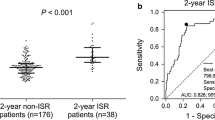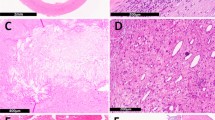Abstract
The aim of this study was to evaluate fibroblast growth factor (FGF)-23 serum levels and its tissue expression in patients with critical carotid artery stenosis (CAS). We selected 35 patients with critical CAS undergoing carotid thromboendoarterectomy. In each patient, FGF-23 serum levels were evaluated just prior to the surgery (t0) and 30 min (t1) thereafter. Moreover, macrophage cytokines were measured at baselines. Carotid artery specimens were used for immune histochemistry. On the basis of the histology, the patients were divided into 2 groups: A with complicated plaque and B with uncomplicated plaque. Twenty complicated plaques (57.14 %, group A,) and 15 uncomplicated (42.86 %, group B) were evaluated: calcifications were present in 16/20 (80 %) complicated plaques and in 6/15 (40 %) uncomplicated plaques. An inflammatory infiltrate was observed in 26/35 carotid samples: 18/26 (69.23 %) complicated and 8/26 (30.76 %) uncomplicated. FGF-23+ cells were present in 17/20 complicated (85 %) and in 8 uncomplicated (53 %) plaques. The double-staining immunofluorescence confirmed that macrophage cells (CD68+) were also positive for FGF-23 staining. Serum levels of FGF-23 were significantly higher in group A versus group B at t0 (p < 0.05) and t1 (p 0.0047). Moreover, in group A patients a significant increase of FGF-23 serum levels was observed at t1 in comparison with t0 (p 0.0011). Our results suggest that FGF-23 acts in the late phases of atherosclerotic disease and may potentially represent a marker of complications in critical CAS.




Similar content being viewed by others
References
Riminucci M, Collins MT, Fedarko NS et al (2003) FGF-23 in fibrous dysplasia of bone and its relationship to renal phosphate wasting. J Clin Invest 112:683–692
Shimada T, Hasegawa H, Yamazaki Y et al (2004) FGF-23 is a potent regulator of vitamin D metabolism and phosphate homeostasis. J Bone Miner Res 19:429–435
Goldsmith DJ, Cunningham J (2011) Mineral metabolism and vitamin D in chronic kidney disease–more questions than answers. Nat Rev Neprhol 7:341–346
Moe SM, Chen NX (2008) Mechanisms of vascular calcification in chronic kidney disease. J Am Soc Nephrol 19(2):213–216
Isakova T, Xie H, Yang W et al (2011) FGF-23 and risks of mortality and end-stage renal disease in patients with chronic kidney disease. JAMA 305:2432–2439
Gutierrez OM, Mannstadt M, Isakova T et al (2008) FGF-23 and mortality among patients undergoing hemodialysis. N Engl J Med 359:584–592
Gutierrez OM, Januzzi JL, Isakova T et al (2009) FGF-23 and left ventricular hypertrophy in chronic kidney disease. Circulation 119:2545–2552
NasrAllah MM, El-SheHaby AR, Osman NA et al (2013) The association between fibroblast growth factor-23 and vascular calcification is mitigated by inflammation markers. Nephron Extra 3:106–112
Mirza MA, Larsson A, Melhus H, Lind L, Larsson TE (2009) Circulating FGF-23 is associated with vascular dysfunction in the community. Atherosclerosis 205:385–390
Arnlov J, Lind L, Larsson Tobias E (2013) Higher fibroblast growth factor-23 increases the risk of all-cause and cardiovascular mortality in the community. Kidney Int 83:160–166
Mirza MA, Hansen T, Johansson L et al (2009) Relationship between circulating FGF23 and total body atherosclerosis in the community. Nephrol Dial Transplant 205:385–390
Raman G, Moorthy D, Hadar N et al (2013) Management strategies for asymptomatic carotid stenosis: a systematic review and meta-analysis. Ann Intern Med 158:676–685
Stary HC, Chandler AB, Dinsmore RE et al (1995) A definition of advanced type of atherosclerotic lesions and a histological classification of atherosclerosis. A report from the Committee on Vascular Lesions of the Council on Arteriosclerosis, American Heart Association. Circulation 92:1355–1374
Hansson GK (2005) Inflammation, atherosclerosis and coronary artery disease. N Engl J Med 352:1685–1695
Mendoza JM, Isakova T, Ricardo AC et al (2012) Fibroblast growth factor 23 and inflammation in CKD. Clin J Am Soc Nephrol 7:1155–1162
Del Porto F, Proietta M, Tritapepe L et al (2010) Inflammation and immune response in acute aortic dissection. Ann Med 42:622–629
Lindeman JH, Abdul-Hussein H, Schaapherder AF et al (2008) Enhanced expression and activation of pro-inflammatory transcription factors distinguish aneurysmal from atherosclerotic aorta: IL-6 and IL-8 dominated inflammatory responses prevail in the human aneurysms. Clin Sci (London) 114:687–697
Proietta M, Tritapepe L, Cifani N, Ferri L, Taurino M, Del Porto F (2014) MMP-12 as a new marker of Stanford-A acute aortic dissection. Ann Med 46:44–48
Charo IF, Ransohoff RM (2006) The many roles of chemokines and chemokine receptors in inflammation. N Engl J Med 354:610–621
Benagiano M, Munari F, Ciervo A et al (2012) Chlamydophila pneumonia phospholipase D (CpPLD) drives Th17 inflammation in human atherosclerosis. PNAS 109:1222–1227
Liu ZD, Wang L, Lu FH et al (2012) Increased Th17 cell frequency concomitant with decreased Foxp3 + Treg cell frequency in the peripheral circulation of patients with carotid artery plaques. Inflamm Res 61(10):1155–1165
Ozkok A, Kekik C, Karahan GE et al (2013) FGF-23 associated with the progression of coronary artery calcification in hemodialysis patients. BMC Nephrology 14:241–248
Masai H, Joki N, Sugi K, Moroi M (2013) A preliminary study of the potential role of FGF-23 in coronary calcification in patients with suspected coronary artery disease. Atherosclerosis 226:228–233
Scialla JJ, Lau WL, Reilly MP et al (2013) Fibroblast growth factor 23 is not associated with and does not induce arterial calcification. Kidney Int 83:1159–1168
Balci M, Kirkpantur A, Gulbay M et al (2010) Plasma fibroblast growth factor-23 levels are independently associated with carotid artery atherosclerosis in maintenance hemodialysis patients. Hemodial Int 14:425–432
Asicioglu E, Kahveci H, Arikan H, Koc M, Tuglular S, Ozener C (2014) Fibroblast growth factor-23 levels are associated with uric acid but not carotid intima media thickness in renal transplant recipients. Transplant Proc 46:180
Kestenbaum B, Sachs MC, Hoofnagle AN (2014) Fibroblast growth factor-23 and cardiovascular disease in the general population. Circ Heart Fail 2014(7):409
Wu B, Pei X, Li ZY (2014) How does calcification influence plaque vulnerability? Insights from fatigue analysis. Sci World J 2014:417324. doi:10.1155/2014/417324
Acknowledgments
This study was funded by the Università di Roma “La Sapienza”, Progetto di Ricerca di Università Anno: 2010-prot. C26A10ETWL
Conflict of interest
The authors have no conflict of interest to declare, including specific financial interest or relationship with pharmaceutical companies, biomedical device manufacturers, or other corporations whose products or services are related to the subject matter of the article. Such relationships include employment by any industrial concern, ownership of stock, membership on a standing advisory council or committee, being on the board of directors or being publicly associated with the company of its products. Moreover, the authors declare that they have not received honoraria, fees, grants or funds from such corporations or individuals representing such corporations.
Author information
Authors and Affiliations
Corresponding author
Rights and permissions
About this article
Cite this article
Del Porto, F., Proietta, M., di Gioia, C. et al. FGF-23 levels in patients with critical carotid artery stenosis. Intern Emerg Med 10, 437–444 (2015). https://doi.org/10.1007/s11739-014-1183-3
Received:
Accepted:
Published:
Issue Date:
DOI: https://doi.org/10.1007/s11739-014-1183-3




